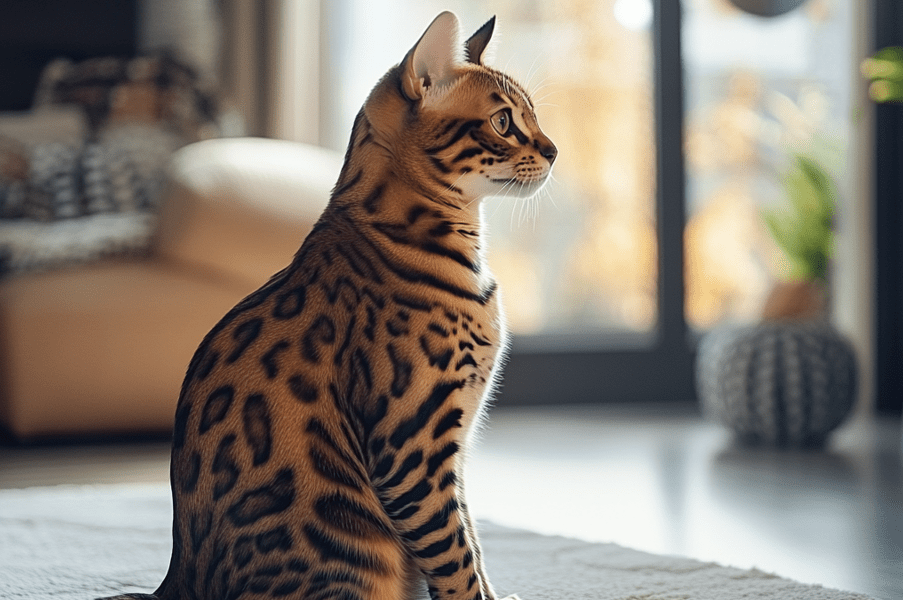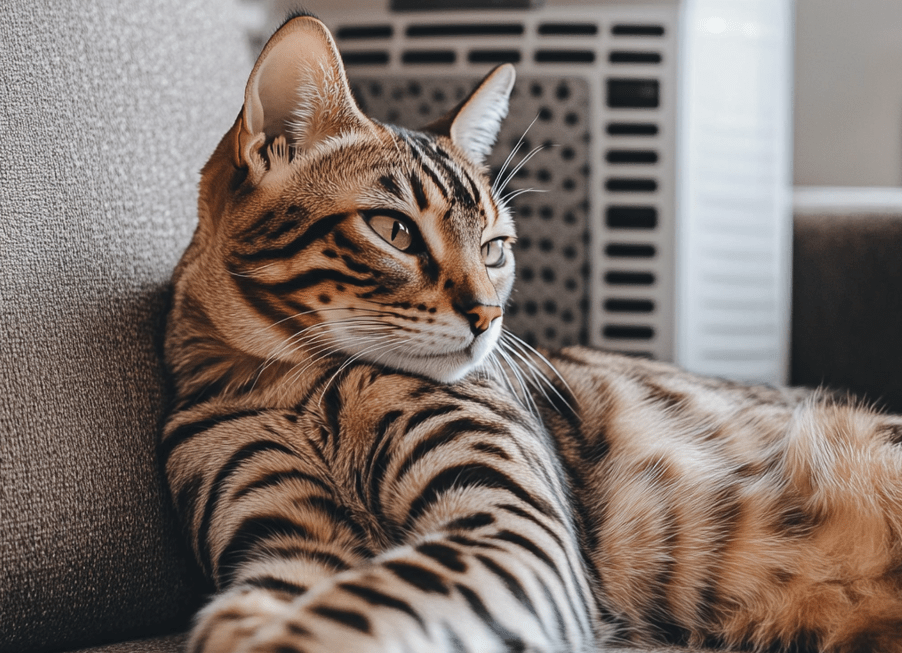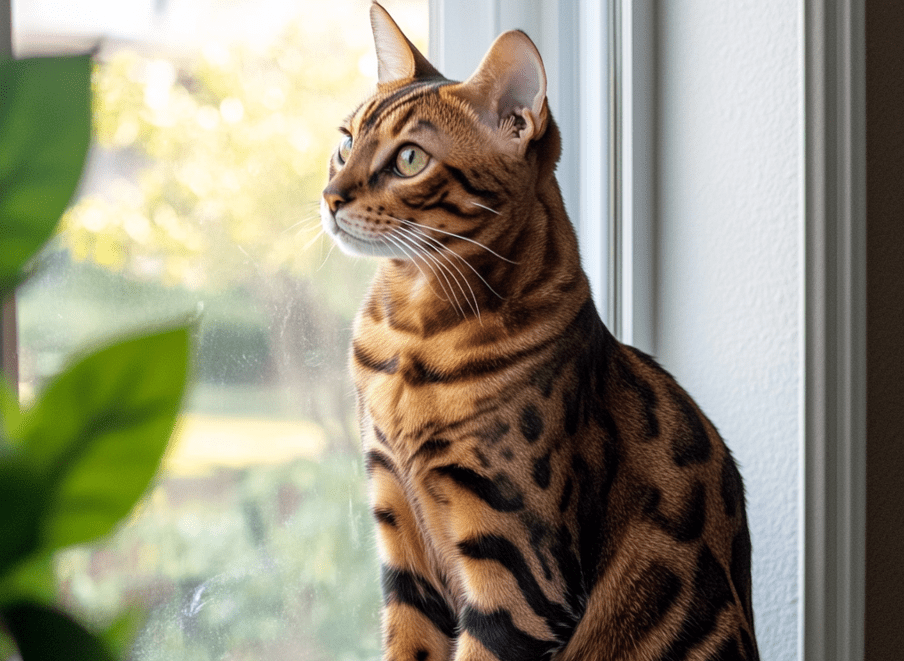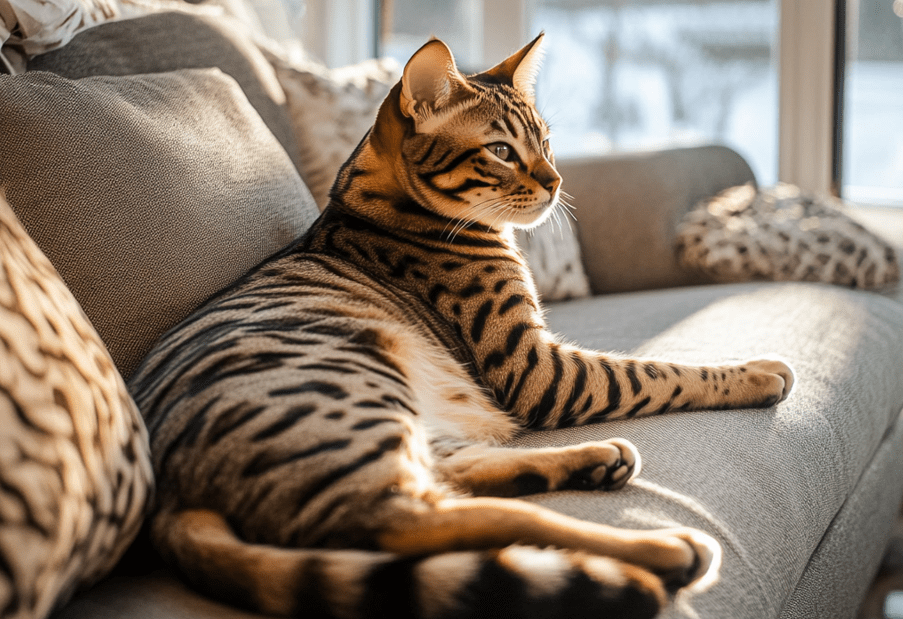
Bengal kittens are known for their striking appearance and playful personalities. But Bengal kitten care goes beyond just providing food and shelter. In this article, we will explore the key elements of Bengal kitten care –
Keeping Your Kitten Safe and Healthy

Bengal kittens are very sharp, and their favorite toys can be harmful to them, such as blind cords, electric wires, or toxic plants. They can damage curtains or good furniture with their little sharp claws. Therefore, cat-proofing measures are necessary.
Kittens need twice the nutrition compared to adult cats. They should be fed food labeled “kitten.” Make sure there is always a bowl of kibble and a bowl of fresh water available. Bengal cats love to get water, so do not forget to provide fresh water every morning, otherwise, they may drink from the sink or toilet. Cats should always be free-fed, and the diet should be switched to “adult” food within a year, although this depends on whether they have been spayed or neutered. The right time should be determined by talking with your veterinarian.
Bengal cats want to eat more meat compared to other domestic cats. Some breeders feed them lean red beef in addition to their regular diet, and some only eat raw meat. Regular hamburgers contain a lot of fat, which can upset their stomachs. Ground round, ground sirloin, or beef heart are good alternatives for Bengals.
Do’s and Don’ts When Feeding Bengal Cats and Kittens

You should not feed your kitten dog food. Cats require taurine, which is not present in dog food. A deficiency of taurine can lead to heart disease or blindness.
You should not give your kitten food scraps, and you should not supplement its diet with milk, as this can cause indigestion and diarrhea. If you encourage this behavior, your kitten will eat foods that do not contain the necessary nutrients.
You should not feed your kitten liver, canned tuna, or other canned fish made for humans. These foods can create an imbalance of vitamins A, D, and E, which can lead to serious health issues.
You should feed them a balanced premium food specifically formulated for kittens. These kittens require more protein for strong bones and muscle development and need higher calorie levels to maintain their energy compared to adult cats.
Claw Trimming & Scratching

Gently apply pressure to each toe to extend the claws and carefully trim the sharp tips. It is better to trim less than to trim too much, as there is a vein within the nail. This vein is red or pink in color, and it can be difficult to see when small. Make sure you do not cut back so far that you hit this vein, as it can harm the kitten and potentially cause bleeding. The trimming process should not be a battle; you can cut just a few nails at a time the first time, and that’s okay. Using a nail clipper designed for children’s nails generally seems easier.
To prevent your kitten from scratching furniture, buy two or more “sisal” scratching posts, which are readily available. Sprinkle catnip on the scratchers or use catnip spray every few days while the kitten is small to attract them. I like to keep one vertical and one angled or flat scratcher. Place these in the busiest areas of your home, as that’s where your cat will often be.
If you see your kitten scratching your furniture, clap your hands or shout “no, no!” to startle them. Squirt bottles also work well. They will quickly learn what things to scratch.
Bengal Kitten Litter Box Training

If you have a two-story house, you should have a litter box on each floor while the kitten is small. Once the kitten grows and becomes comfortable throughout the house, you can remove one litter box when it doesn’t want to go downstairs to use the bathroom while busy playing upstairs.
If your kitten follows you from one room to another, it will always see a box, which reduces the chances of accidents. If the kitten cannot see its box, it will find a corner while it is still small. As the kitten grows, you can gradually remove the litter boxes. My kittens always used a box by 13 weeks of age.
You can use clumping or non-clumping litter. If the kittens eat the litter, we need to use non-clumping litter. After 9 weeks of age, this generally does not become a problem. The litter box should be cleaned frequently, as Bengals do not like dirty litter boxes.
If you already have a cat when bringing your Bengal home, do not force them to share a box. Once it becomes clear that they are friends, they can share a box.
New Bengal Kitten Not Eating?

Sometimes, due to the stress of leaving their mother and siblings, a kitten may not want to eat after arriving at their new home. Although they may be playing, purring, and appearing happy, they may still be under a lot of stress from the change.
To ensure your kitten is eating, you can offer them wet food a few hours after bringing them to their new home. If you warm it slightly, it will become more appealing and tastier for them. I recommend feeding your kitten wet food daily for the first two weeks to ensure they are eating well.
This is a great way to bond with your cat, as they will associate you with something they love! You can sit beside them to pet them or talk to them while they eat. Expect to hear some silly sounds; this is a characteristic of Bengal cats. Ha ha!
Treats for Bengal Cats

Remember, most human food is not good for your Bengal cat. Their favorite food is chicken, and you can boil some chicken legs to let them eat the meat; they will love it!
If you want to spoil your kitten with a delicious meal, give them chicken, wet kitten food, or high-quality cat food. If you don’t want to boil chicken, deli turkey meat is a great alternative. It has minimal seasoning, and our kittens love it!
However, we make them work for this food a bit by giving high fives or doing some other tricks first!
Tips for Teething Bengal Kittens

Remember, your kitten will continue to teethe until about 8 months of age. When they start teething, they need appropriate things to chew on. You can use various cat toys, small stuffed animals, and even plastic drinking straws. Keep some toys in every room, and when your kitten starts to bite, even during play, give them a toy.
If your kitten is still biting, please do this: When the kitten bites you, pick them up in the way their mother would carry them.
Your new kitten will likely cry for the first few nights being with you. It won’t be endless, but it will happen. Comfort them and speak calmly, assuring them that everything is okay. They are in an unfamiliar place and miss their mother and siblings. Do not yell at them, as this can cause a lot of stress.
This is generally a great time for bonding for both of you and companionship for the kitten. The kitten will look to you as a maternal figure since its mother is no longer present. Initially, give the kitten plenty of attention and spend as much time as possible with them so they bond with you.
Safe Play and Toy Selection

Don’t forget to use safe toys for your cat. The toys should not be too small so that they cannot choke on them. If you have small children’s toys in your home, you need to be especially careful. Long string toys should be used under supervision. Some Bengal kittens become very possessive over certain types of toys, and it depends on the kitten which type of toy they will become possessive about. Feather toys and crinkly toys seem to be the most common.
If someone gets too close to their toy, they will roar fiercely like a tiger. I’ve never had a kitten bite me while guarding their toys; they only roar. It seems more like play to them, as all of mine enjoy tugging at the toys while they are roaring.
Leash Training and Outdoor Safety

If you plan to walk your cat on a leash, make sure to buy them a walking vest. First, get them accustomed to wearing it around the house. Then, add the leash and encourage them to walk with you like a puppy. Once they are completely comfortable, you can take them outside. Initially, walk them in a safe place like your backyard.
When you go out for a walk, always take your cat with you when you leave through the door and when you return home. Never let them go in or out through the door alone. Hopefully, this will discourage them from trying to escape, but there are no guarantees. It completely depends on the cat.
Once they get a taste of being outside, some become obsessed with it. This should be kept in mind before deciding to take your cat outside. Never let your cat go outside unattended.
Correcting Unwanted Behavior

If your cat or kitten is doing something they shouldn’t, you can shout a firm “no!” and clap your hands loudly. This usually stops the behavior. A squirt bottle also works well. If your cat or kitten jumps on the counter or gets into your plants, spray them with water, and they will associate this behavior with something they dislike.
If you feed your Bengal from your plate, you should expect that they will always want to be on your counter and will try to steal food directly from your plate! Personally, I never feed any of my cats from our plates, so I have no issues with that. I recommend doing the same with your kitten.
Also, be cautious when thawing frozen meat. Some kittens will never be a bother, while others may pull a whole chicken out of the sink and drop it on the floor! We always thaw meat in places where our cats cannot reach.




